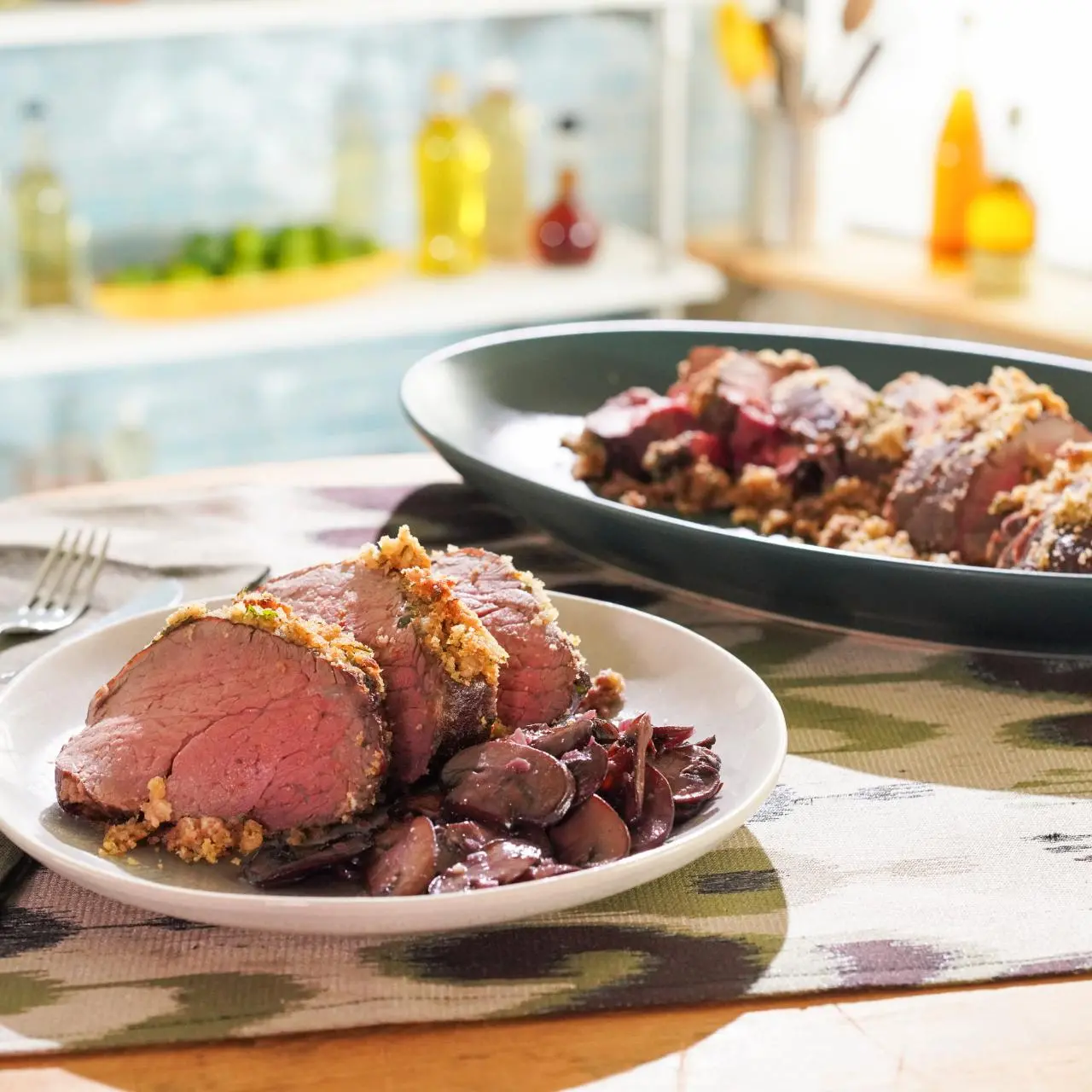Introduction
Embark on a culinary journey with this exquisite Horseradish-Crusted Tenderloin recipe, a dish that combines bold flavors, expert technique, and elegant presentation. Crafted for both novice cooks and seasoned chefs, this recipe brings out the best in premium beef tenderloin by complementing its tenderness with a spicy horseradish crust and aromatic herbs. The result is a dish that embodies sophistication and comfort, perfect for special occasions, celebratory dinners, or simply elevating your weekend menu. At Love With Recipes, we believe that mastering such a dish not only impresses guests but also elevates your culinary confidence, offering a gourmet experience made accessible with precise instructions and thoughtful tips.
Time
- Prep Time: 15 minutes
- Cook Time: 20 minutes
- Total Time: 35 minutes
- Marination Time: 1 to 2 hours (optional but recommended for deeper flavor)
Needed Equipment
- Chef’s knife and cutting board
- Meat thermometer
- Mixing bowls
- Whisk
- Plastic wrap or airtight container for marinating
- Grill or oven (depending on preferred cooking method)
- Grill tongs or spatula
- Aluminum foil (for resting the meat)
- Basting brush (optional, for applying marinade or oil)
- Meat tenderizer (optional, for prepping the beef)
- Serving platter
- Thermometer probe (digital or analog)
Tags
Spicy, Gourmet, Beef, Main Course, Elegant, Quick, Easy, Roast, Grilled
Serving Size
This recipe serves approximately 4 to 6 people, depending on portion sizes and sides served.
Difficulty Level
Intermediate. The recipe involves marination, precise cooking to desired doneness, and proper resting techniques to ensure tender, flavorful results. However, with careful attention to instructions and temperature control, it remains accessible for home chefs with some experience in handling meats.
Allergen Information
- Mustard: Contains mustard seeds or mustard powder in creole mustard
- Garlic: Common allergen
- Olive Oil: Suitable for most but check for allergies
Dietary Preference
Gluten-Free: Ensure creole mustard is certified gluten-free. Can be adapted for keto, paleo, or low-carb diets. Suitable for low-fat diets if excess oil is minimized.
Course
Main Course
Cuisine
American / Contemporary Gourmet
Ingredients
Ingredient Table
| Quantity | Ingredient |
|---|---|
| 1/2 cup | Creole mustard |
| 1/4 cup | Minced garlic |
| 10 – 12 | Olive oil |
| 2 tbsp | Cracked black pepper |
| 2 | Kosher salt |
| 1 | Sea salt |
| To taste | Additional cracked black pepper |
| 1.5 – 2 lbs | Beef tenderloin (center-cut, trimmed) |
| Optional | Cayenne pepper (for extra heat) |
Instructions
1. Prepare the Horseradish Mixture
Begin by assembling your flavor base. In a medium mixing bowl, combine the creole mustard, minced garlic, olive oil, and cracked black pepper. Whisk thoroughly until all ingredients are well integrated into a smooth, cohesive mixture. The purpose of this mixture is to create a flavorful crust that will both season and add heat to the beef tenderloin. For a more intense horseradish flavor, you can adjust the quantity of horseradish or add a splash of prepared horseradish sauce. For those who prefer milder heat, reduce the black pepper or skip the cayenne pepper altogether. The mixture should have a slightly spicy, pungent aroma and a thick consistency suitable for spreading.
2. Prepare the Beef Tenderloin
Choose a high-quality, center-cut beef tenderloin. This cut is prized for its tenderness and mild flavor, making it perfect for crusting with bold flavors. Before applying the horseradish mixture, pat the tenderloin dry with paper towels to remove excess moisture, which helps the crust adhere better. If the tenderloin has a thick layer of fat or silverskin, trim it carefully with a sharp knife. Optionally, you can tenderize the meat lightly with a meat mallet or tenderizer to enhance juiciness and even cooking. Allow the beef to come to room temperature for about 30 minutes before cooking; this ensures uniform heat distribution and more predictable doneness.
3. Coat the Beef with the Horseradish Mixture
Using a silicone spatula or a spoon, generously spread the prepared horseradish mixture all over the beef tenderloin, covering every surface evenly. For an even crust, work from the center outward, ensuring that the entire surface is coated. For added flavor, you can marinate the coated beef in plastic wrap or an airtight container in the refrigerator for 1 to 2 hours. This marination step allows the flavors to penetrate deeper into the meat, resulting in a more robust taste. If short on time, you can proceed directly to the next step, but longer marination enhances flavor complexity.
4. Season the Beef
After marination, season the beef lightly with kosher salt and additional cracked black pepper to taste. Be cautious with salt, as creole mustard and the marinade already contain salt, and over-seasoning can overpower the dish. Salt enhances flavor and helps create a slight crust during cooking. If you desire an extra spicy kick, sprinkle a pinch of cayenne pepper at this stage. Massage the seasoning gently into the crusted surface to ensure even distribution. Resting the seasoned beef for 10-15 minutes before cooking allows the salt to penetrate, further enhancing flavor and tenderness.
5. Cooking the Tenderloin
Preheat your grill or oven to the appropriate temperature. For grilling, aim for a medium heat—around 350°F (175°C)—ensuring a hot, even heat source. For oven roasting, set the oven to 400°F (200°C). If using a grill, clean the grates thoroughly and oil them lightly to prevent sticking. Place the beef on the grill rack or a roasting pan, depending on your cooking method. Cook the tenderloin until it reaches your desired internal temperature: 125°F (52°C) for rare, 135°F (57°C) for medium, or 145°F (63°C) for medium-well. Use a meat thermometer inserted into the thickest part of the meat for accuracy. Turn the beef periodically to promote even cooking and develop attractive grill marks or a uniform crust.
6. Resting and Slicing
Once the beef reaches the target temperature, remove it from the heat source and tent loosely with aluminum foil. Rest the meat for at least 5 minutes, which allows the juices to redistribute throughout the tenderloin, ensuring each slice is moist and flavorful. Resting is critical for optimal texture and flavor; slicing immediately will result in a loss of juices and a drier final product. Use a sharp carving knife to cut the tenderloin into thick, even slices. Serve immediately, garnished if desired with fresh herbs or a drizzle of olive oil.
Preparation Tips
- Use a digital meat thermometer to monitor internal temperature accurately.
- For a more pronounced crust, sear the beef in a hot skillet for 2-3 minutes per side before finishing on the grill or in the oven.
- Ensure the beef is at room temperature before cooking to promote even doneness.
- Use high-quality creole mustard for a richer flavor and better crust adhesion.
- Experiment with herbs such as thyme or rosemary added to the horseradish mixture for additional aroma.
Nutritional Information
| Nutrient | Per Serving (Approximate) |
|---|---|
| Calories | 475 kcal |
| Fat Content | 38.1 g |
| Saturated Fat | 14.2 g |
| Cholesterol | 106 mg |
| Sodium | 193.4 mg |
| Carbohydrate | 3.7 g |
| Fiber | 1 g |
| Sugar | 0.1 g |
| Protein | 28.5 g |
Tips and Tricks
- For an extra layer of flavor, add a teaspoon of Dijon mustard to the horseradish mixture.
- If you prefer a crust with more texture, coat the beef with finely chopped herbs or toasted breadcrumbs mixed into the horseradish sauce.
- Use a cast-iron skillet to sear the beef before grilling or roasting for a deeply caramelized crust.
- Adjust cooking times based on the thickness of your tenderloin; thicker cuts require more time.
- For a smoky flavor, add wood chips to the grill or use a smoker box.
Add-ons
- Horseradish cream sauce—mix prepared horseradish with sour cream or Greek yogurt for a cooling complement.
- Caramelized onions or sautéed mushrooms as a savory topping.
- Fresh herbs such as parsley, chives, or thyme for garnish.
- Spicy mustard or a balsamic glaze drizzled over slices for added depth.
Side Dishes
- Roasted root vegetables (carrots, parsnips, sweet potatoes)
- Garlic mashed potatoes or cauliflower mash
- Simple green salad with vinaigrette
- Grilled asparagus or green beans
- Crusty artisan bread or dinner rolls
Improvements
- For a more complex flavor, incorporate a splash of red wine or beef stock into the marinade or during resting.
- Experiment with different herbs, such as tarragon or basil, in the horseradish mixture for unique flavor profiles.
- Use a sous-vide method for precise temperature control, then sear at high heat for crust formation.
- For a crust with a gourmet touch, sprinkle with toasted crushed nuts or seeds before cooking.
Save and Store
Leftover cooked tenderloin can be stored in an airtight container in the refrigerator for up to 3 days. For longer storage, wrap tightly in plastic wrap and foil, then freeze for up to 2 months. To reheat, gently warm in a low oven or microwave, ensuring not to overcook and dry out the meat. The horseradish crust is best enjoyed fresh; however, the cooked beef can be sliced and stored separately to preserve texture.
FAQ
Can I make this recipe ahead of time?
While the beef benefits from marination, it’s best to cook and serve within a few hours for optimal freshness. You can prepare the horseradish mixture in advance and store it in the refrigerator for up to 24 hours. Marinate the beef for 1-2 hours beforehand.
What is the best internal temperature for tenderness?
For a tender, juicy result, aim for 125°F (52°C) for rare, 135°F (57°C) for medium, and 145°F (63°C) for medium-well. Use a reliable meat thermometer to ensure accuracy.
Can I use a different cut of beef?
Yes, but tenderloin is preferred for its tenderness and ability to cook quickly. For a similar experience, sirloin or ribeye can be substituted, but cooking times and results may vary.
Is this suitable for a low-carb diet?
Absolutely. This recipe is naturally low in carbs, making it compatible with keto, paleo, and low-carb lifestyles.
Conclusion
Mastering the art of preparing a horseradish-crusted tenderloin elevates your home cooking to restaurant-quality status. The combination of tender beef, spicy horseradish crust, and perfectly balanced seasonings creates a memorable dining experience that impresses guests and delights family alike. Whether you’re celebrating a special occasion or simply indulging in a gourmet meal, this recipe offers versatility, flavor, and elegance. Remember, attention to detail—such as proper marination, precise temperature control, and resting—is key to achieving the perfect result. For more exclusive recipes and culinary tips, visit Love With Recipes, where we strive to bring you the best in home-cooked excellence.
References
1. The Science of Good Cooking by Cook’s Illustrated
2. The Flavor Bible by Karen Page and Andrew Dornenburg


